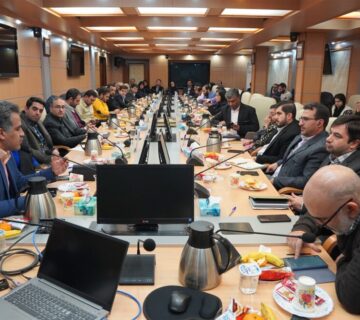A specialized meeting titled “Development of Co-Investment Instruments” was held on Tuesday, February 12, with the participation of Dr. Mojtaba Zare Mehrjerdi (Deputy of Investment at the Innovation and Prosperity Fund), Eng. Ebrahim Rostegari (Head of the Office for Innovative and Knowledge-Based Companies at the Vice-Presidency for Science, Technology and Knowledge-Based Economy), Dr. Hamed Rafiei (Head of the Center for Financing and Investment Development at the Vice-Presidency for Science), Dr. Mohammad Hossein Sajjadi Niari (Chairman of the Board of the National Venture Capital Association of Iran), and several members of the Association, at the premises of the Innovation and Prosperity Fund.
The meeting centered on discussing and exchanging views on the Innovation and Prosperity Fund’s “10-Trillion IRR Co-Investment Program with Leading Startups,” with the active involvement of the National Venture Capital Association of Iran, serving as a specialized arm of the country’s innovative investment ecosystem.
During the session, Dr. Zare Mehrjerdi emphasized the need for designing innovative financial instruments tailored to the needs of the innovation ecosystem. He highlighted objectives such as diversifying services, expanding the target audience, enhancing the effectiveness of support mechanisms, addressing national macroeconomic challenges, and increasing the share of the knowledge-based economy in the GDP. He also elaborated on various co-investment models, including collaboration with accelerators, RTF, VC, PE, CVC, and bank-led CVCs (under Article 18).
He further underlined the necessity of redesigning the co-investment model within the operational framework of the Innovation and Prosperity Fund. The new model aims to delegate investment responsibilities to intermediary institutions, strengthen the monitoring system, accelerate project approvals, ensure timely financial disbursements, and enhance risk management.
Dr. Zare Mehrjerdi outlined the Fund’s main investment missions in four key areas: (1) developing the venture capital market from the supply perspective, (2) facilitating resource mobilization and encouraging the entry of new players, (3) completing financial tools and models with a focus on the growth of professional institutions, and (4) designing complementary instruments to improve investment quality and complete the financial supply chain.
Later in the meeting, the Chairman and members of the National Venture Capital Association contributed their expert perspectives and analyses, playing a pivotal role in steering the discussion. The Association’s active involvement, as the representative of the private venture capital sector, was particularly noted for its role in shaping the operational mechanisms of the program.
It was concluded that further discussions and consolidation of the topics raised would continue in upcoming sessions with other members of the Association, leading to final proposals being submitted to the Fund in collaboration with this specialized body.
With the effective participation of the National Venture Capital Association, this meeting facilitated constructive engagement between governmental entities and the private sector for the advancement of innovative financial tools. By contributing its specialized viewpoints and leveraging the experience of its members, the Association played an active role in shaping the discussions, designing implementation mechanisms, and improving the efficiency of co-investment models. The continuation of such collaboration is expected to play a crucial role in completing the innovation financing chain and expanding the venture capital market. Given the Association’s position as a specialized institution and a key platform for dialogue between investors and policymakers, its active engagement in such forums can significantly enhance national-level decision-making. One of the main themes highlighted in this event was the importance of increasing synergy between public and private sector players—a goal in which the Association played a central role. Sustaining this momentum can pave the way for more effective policy design in support of innovative companies and the empowerment of private financial institutions.




No comment